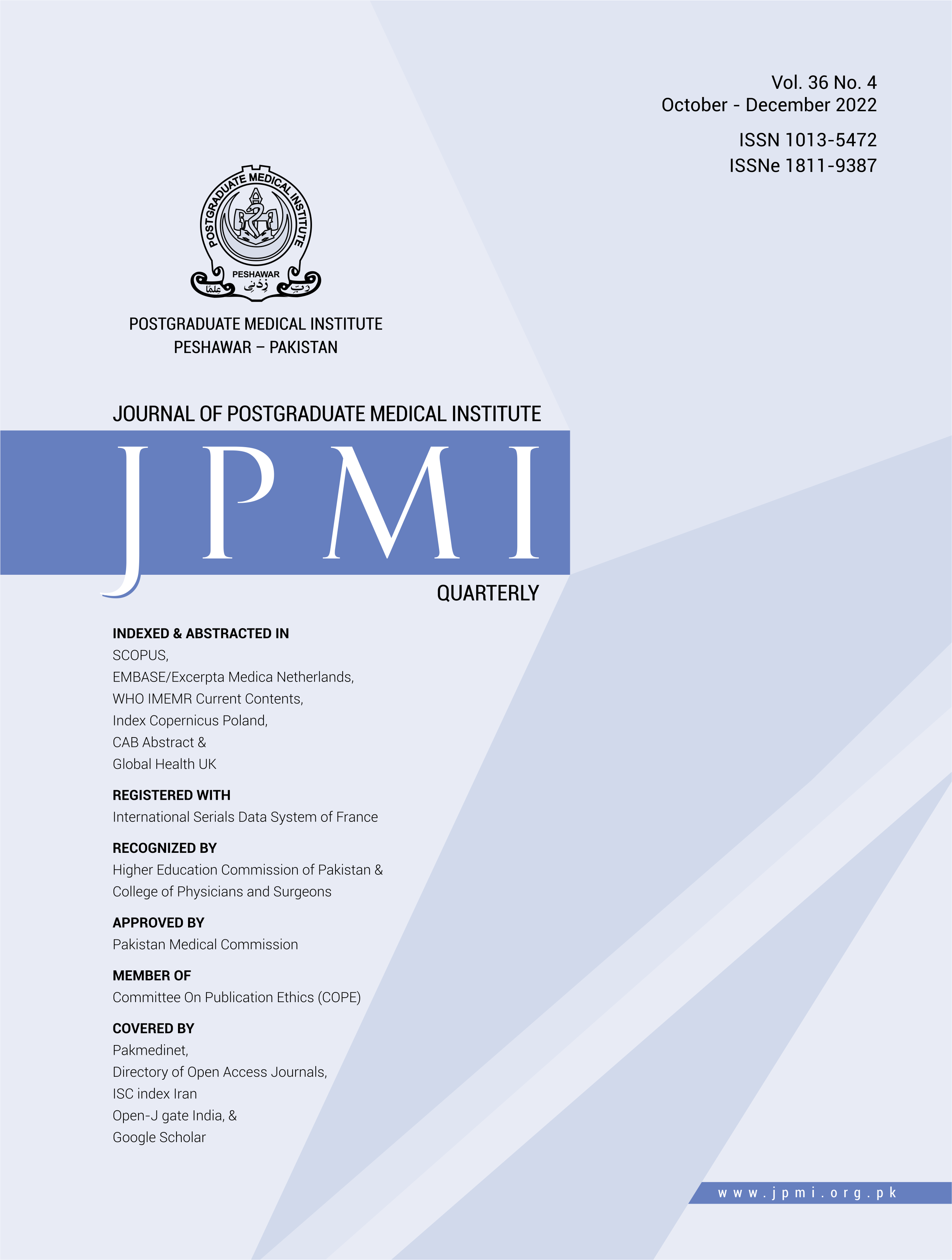FETOMATERNAL OUTCOME IN DIFFERENT MODES OF DELIVERY IN PATIENTS WITH ECLAMPSIA
Main Article Content
Abstract
Objective: To evaluate the fetomaternal outcomes of different modes of delivery in pregnancies complicated by eclampsia at and after 24 weeks.
Methodology: We conducted a prospective observational study of 352 women, aged 14-47 years, with eclampsia at >24 weeks of gestation at the Department of Obstetrics & Gynaecology, Women and Children Hospital Bannu, Pakistan from April 2017 to Dec 2018. The primary outcome measures were maternal mortality and maternal near-miss. The secondary outcome measures were perinatal morbidity and mortality.
Results: There were 172 women in the vaginal delivery (VD) and 180 in the cesarean delivery (CD) group. The mean age was 31.46 ±10.17 years (range 14-47 years). Most of the women were 21-40 years, 179 (50.85%). There were more unbooked and referred cases in the CD group, 171 (95%) versus 150 (87.2%) (p<0.05), and 131 (72.8%) versus 63 (36.6%) (p<0.000) respectively. The VD group had more maternal deaths, (13.40% versus 6.11%, p<0.021), severe maternal outcomes, (47.09% versus 14.44%, p<0.000), and life-threatening complications, (33.72% versus 8.88%, p<0.000); HELLP (5.81% versus 1.66%, p<0.039), DIC (4.65% versus 0.55%, p<0.015), cardiac dysfunction (3.48% versus 0%, p<0.011), and sepsis (4.65% versus 1.11%, p<0.046). The perinatal outcome was also poor in women with a VD, with higher stillbirths (20.93% versus 07.77%, p<0.000), and perinatal deaths (31.39% versus 12.77%, p<0.000).
Conclusion: Eclampsia is associated with grave fetomaternal complications. There is an increase in the number of elective CD in women with eclampsia, which is associated with less morbidity and mortality than VD.
Article Details
Work published in JPMI is licensed under a
Creative Commons Attribution-NonCommercial 2.0 Generic License.
Authors are permitted and encouraged to post their work online (e.g., in institutional repositories or on their website) prior to and during the submission process, as it can lead to productive exchanges, as well as earlier and greater citation of published work.
References
Meh C, Sharma A, Ram U, Fadel S, Correa N, Snelgrove JW, Shah P, et al. maternal mortality in India over two decades in nationally representative surveys. BJOG. 2022 Mar;129(4):550- 561. DOI: 10.1111/1471-0528.16888.
National Institute of Population Studies (NIPS) [Pakistan] and ICF. 2019. Paki¬stan Demographic and Health Survey 2017-18, Islamabad, Pakistan, and Rockville, Maryland, USA: NIPS and ICF.
Shah N, Hossain N, Shoaib R, Hussain A, Gillani R, Khan NH, Socio-demographic characteristics and the three Delays of Maternal Mortality. J Coll Physicians Surg Pak. 2009;19:95-8.
Shahzad N, Yaqoob U, Hanif A. Feto Maternal Outcome in Patients with Ec¬lampsia at a Tertiary Care Hospital. Pak J Med Health Sci. 2013;7(1):77.
Nanda SS, Mishra B, Nupur A, Dash S. Maternal and fetal outcome in eclamp¬sia: caesarean vs vaginal delivery. J of Evolution of Medical and Dental Scienc¬es. 2013; 2(37): 7052-60.
Mathai M, Sanghvi H, Guidotti RJ. Major contributors. Managing complications in pregnancy and childbirth: a guide for midwives and doctors. Geneva: De¬partment of Reproductive Health and Research, World Health Organization. 2003.
Saeed G, Wajid R, Dar AY. Mater¬nal mortality in eclampsia after ce¬sarean section versus vaginal de-livery. Ann King Edward Med Univ. 2017;23(4):446–50. DOI:10.21649/ journal.akemu/2017/23.4.451.455
Kumari P, Singh S, Khatun S. Com¬parative study of vaginal delivery and caesarean section in antepartum ec¬lampsia at tertiary care hospital. Int J Reprod Contracept Obstet Gynecol. 2017;6:457–60.
Tukur J, Umar NI, Khan N, Musa D. Comparison of emergency caesarean section to misoprostol induction for the delivery of antepartum eclamptic patients: a pilot study. Niger J Med. 2007;16:364–67. DOI: 10.4314/njm. v16i4.37339
Seal SL, Ghosh D, Kamilya G, et al. Does route of delivery affect maternal and perinatal outcome in women with eclampsia? A randomized controlled pilot study. Am J Obstet Gynecol. 2012;206(6):484.1-7. DOI: 10.1016/j. ajog.2012.04.009.
Chaudhuri S, Giri DK, Mondal A, Rani R, Janani V, Mundle M. Comparison of Fetomaternal Outcome Between Planned Vaginal Delivery and Planned Cesarean Section in Women with Ec¬lampsia: Observational Study. J Obstet Gynaecol India. 2021;71(4):369-378. DOI: 10.1007/s13224-021-01432-x. Epub 2021 Mar 4.
American College of Obstetricians and Gynecologists, Task Force on Hyper¬tension in Pregnancy. Hypertension in pregnancy. Report of the American College of Obstetricians and Gynecol¬ogists’ Task Force on Hypertension in Pregnancy. Obstet Gynecol. 2013;122- 1131.
Chaudhuri S, Nath S. Life-threatening complications in pregnancy in a teach¬ing hospital in Kolkata, India. J Obstet Gynecol India. 2019;69(2):15–22. DOI: 10.1007/s13224-018-1106-8.
Shah N, Khan NH: Third delay of ma¬ternal mortality in a tertiary hospital . Rawal Med J. 2007;32:163-167.
Rahim R, Shafqat T, Ruby NF. An analy¬sis of direct causes of material mortali¬ty. J Postgrad Med Ins 2006;20:86–91.
Shaikh F, Abbas S, Balouch I, Talpur S, Yousfani S, Hashmat F. Frequency and outcome of eclampsia. Gomal J Med Sci. 2016;14(4).
Begum N, Jahan S, Ganguly S, et al. Fetomaternal outcome of vaginal delivery and cesarean section in ec¬lamptic women. J Dhaka Med Coll. 2015;24(2):92–85.
Esteves-Pereira AP, Deneux-Tharaux C, Nakamura-Pereira M, Saucedo M, Bouvier-Colle MH, Leal MD. Caesarean delivery and postpartum maternal mor¬tality: a population-based case-control study in Brazil. PloS one. 2016 Apr 13;11(4):e0153396.
Amorim MMR, Souza ASR, Katz L. Planned caesarean section versus planned vaginal birth for severe pre-ec¬lampsia. Cochrane Database Syst Rev. 2017. DOI:10.1002/14651858. CD009430.pub2.
Vousden N, Lawley E, Seed PT, Gidiri MF, Goudar S, Sandall J, et al. CRADLE Trial Collaborative Group. Incidence of eclampsia and related complica¬tions across 10 low- and middle-re¬source geographical regions: Second¬ary analysis of a cluster randomised controlled trial. PLoS Med. 2019 Mar 29;16(3):e1002775. DOI: 10.1371/ journal.pmed.1002775.


